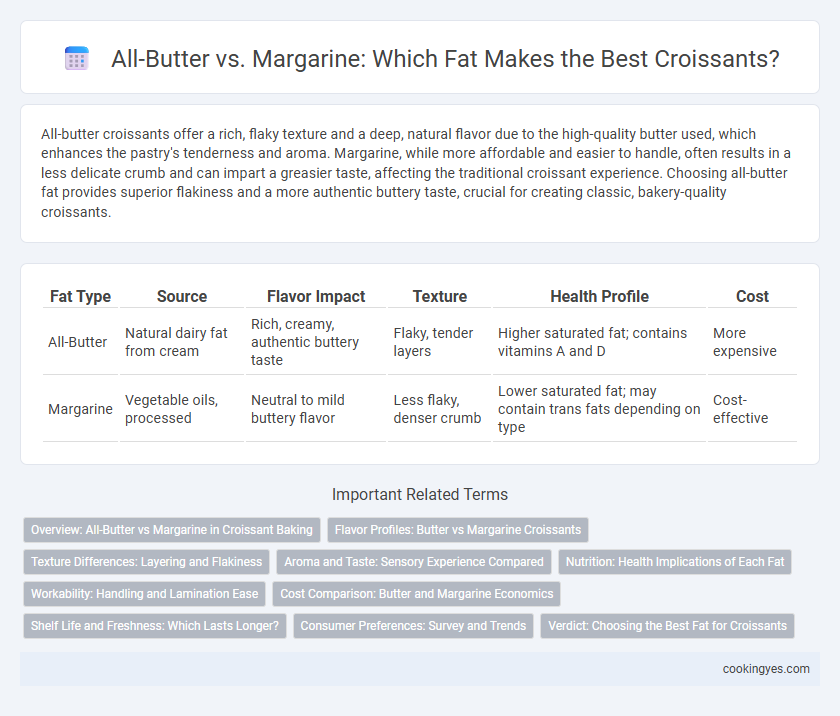All-butter croissants offer a rich, flaky texture and a deep, natural flavor due to the high-quality butter used, which enhances the pastry's tenderness and aroma. Margarine, while more affordable and easier to handle, often results in a less delicate crumb and can impart a greasier taste, affecting the traditional croissant experience. Choosing all-butter fat provides superior flakiness and a more authentic buttery taste, crucial for creating classic, bakery-quality croissants.
Table of Comparison
| Fat Type | Source | Flavor Impact | Texture | Health Profile | Cost |
|---|---|---|---|---|---|
| All-Butter | Natural dairy fat from cream | Rich, creamy, authentic buttery taste | Flaky, tender layers | Higher saturated fat; contains vitamins A and D | More expensive |
| Margarine | Vegetable oils, processed | Neutral to mild buttery flavor | Less flaky, denser crumb | Lower saturated fat; may contain trans fats depending on type | Cost-effective |
Overview: All-Butter vs Margarine in Croissant Baking
All-butter croissants use pure butter, providing a rich flavor and flaky texture due to the natural water content that creates steam during baking. Margarine-based croissants often have a longer shelf life and are more cost-effective, but can lack the depth of flavor and delicate layers achieved with butter. Bakers must balance taste and texture preferences with budget constraints when choosing between all-butter and margarine fats for croissant dough.
Flavor Profiles: Butter vs Margarine Croissants
All-butter croissants deliver a rich, creamy flavor with a distinctive, slightly nutty aroma that enhances the pastry's flaky layers and golden crust. Margarine-based croissants tend to have a milder, more neutral taste, often lacking the depth and complexity found in butter varieties. Choosing butter as the fat source significantly elevates the sensory experience, making croissants more flavorful and aromatic.
Texture Differences: Layering and Flakiness
All-butter croissants offer superior layering and flakiness due to butter's natural plasticity and melting properties, which create distinct, tender layers during baking. Margarine, with a higher melting point and less water content, often results in denser, less flaky texture and less defined layering. Professional bakers prefer all-butter for its optimal lamination and rich mouthfeel that margarine cannot replicate.
Aroma and Taste: Sensory Experience Compared
All-butter croissants deliver a rich, creamy aroma and a complex, buttery flavor that enhances the pastry's sensory appeal, creating a traditional and luxurious taste experience. Margarine-based croissants often lack the depth of aroma and can result in a slightly artificial or neutral flavor profile, compromising the authenticity cherished in classic French viennoiserie. The choice of fat fundamentally influences the croissant's texture and gustatory perception, with all-butter variants favored for their superior mouthfeel and aromatic complexity.
Nutrition: Health Implications of Each Fat
All-butter croissants provide natural saturated fats and fat-soluble vitamins like A and E, promoting better nutrient absorption and a richer flavor profile. Margarine-based croissants often contain trans fats or hydrogenated oils, which are linked to increased risk of cardiovascular diseases and inflammation. Choosing all-butter croissants supports healthier lipid metabolism and reduces exposure to harmful artificial fats commonly present in margarine.
Workability: Handling and Lamination Ease
All-butter croissant dough offers superior pliability and elasticity, making it easier to handle and laminate due to its natural fat content that melts evenly during folding. In contrast, margarine can sometimes be firmer or less consistent in texture, resulting in increased difficulty during lamination and a greater risk of tearing the dough. The workability of all-butter fat ensures thin, even layers, critical for achieving the signature flaky texture in croissants.
Cost Comparison: Butter and Margarine Economics
All-butter croissants typically incur higher production costs due to premium butter prices averaging $4 to $6 per pound compared to margarine, which costs around $1 to $2 per pound. Butter's rich flavor and desirable texture justify the price difference in artisanal bakeries, while margarine offers a cost-effective alternative for large-scale commercial production. Choosing between butter and margarine significantly impacts profit margins, influencing product pricing and consumer perception in the competitive pastry market.
Shelf Life and Freshness: Which Lasts Longer?
All-butter croissants offer superior flavor and a more natural texture, but their shelf life is shorter due to the perishable nature of dairy fats, typically lasting 1-2 days at room temperature. Margarine-based croissants contain hydrogenated fats that extend freshness by inhibiting spoilage, allowing them to stay fresh up to 3-4 days without refrigeration. Choosing all-butter croissants prioritizes taste and quality, while margarine blends enhance durability and convenience for longer shelf stability.
Consumer Preferences: Survey and Trends
Consumer preferences for croissant fat reveal a growing favor towards all-butter croissants due to their rich, authentic flavor and flakier texture compared to margarine-based alternatives. Surveys indicate that 68% of consumers prioritize taste and quality, associating all-butter croissants with artisanal craftsmanship and premium ingredients. Trends show a rising demand for natural, minimally processed products, with all-butter croissants leading in perceived health benefits and gourmet appeal.
Verdict: Choosing the Best Fat for Croissants
All-butter croissants deliver a richer flavor profile and flakier texture due to the natural milk fats and water content, which enhance lamination and browning. Margarine, often containing emulsifiers and a higher melting point, offers consistency and cost-effectiveness but may compromise on aroma and tenderness. For artisanal quality and superior taste, all-butter remains the preferred fat choice in croissant production.
All-Butter vs Margarine for Croissant Fat Infographic

 cookingyes.com
cookingyes.com